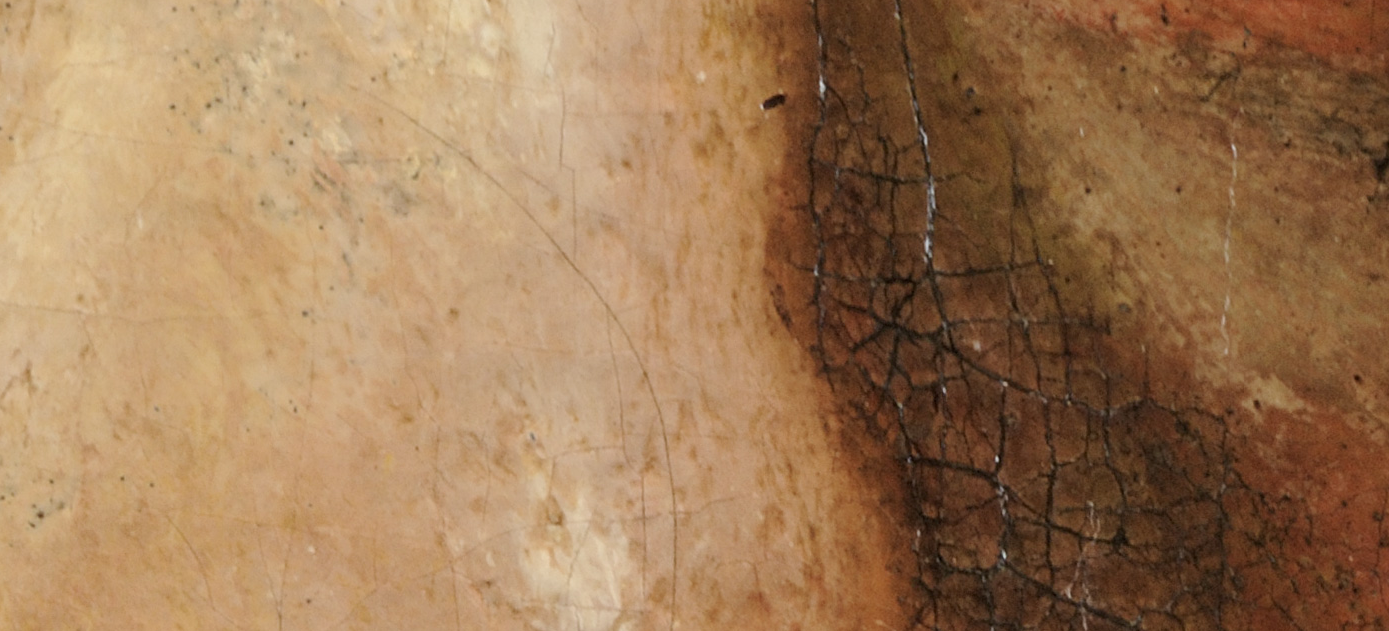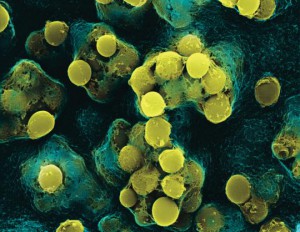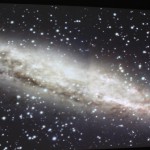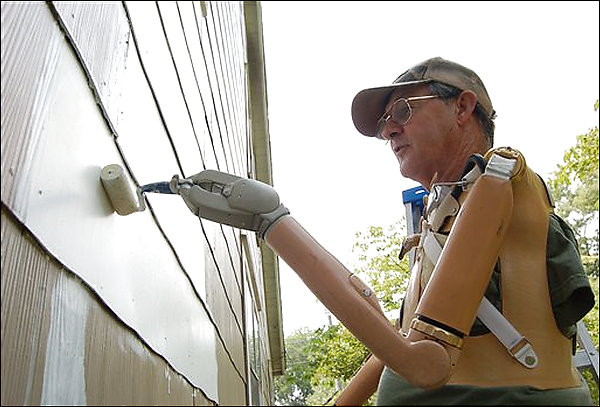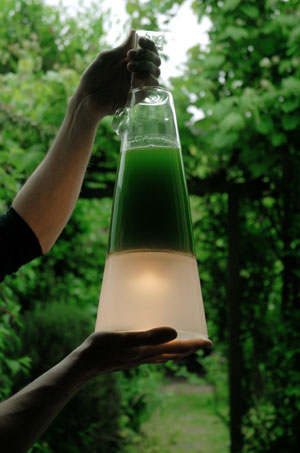As I walked through the exhibition, I imagined at some point that I was not there with my fellow art students, but with a friend of mine who is a biologist. This made me feel excluded; I knew that the content of the works on show contained a lot of ‘scientific’ information of which I didn’t have the slightest clue. What’s the purpose of one of these organisms shown in a framed picture? What does it consist of, how does it function? I felt I couldn’t understand the narrative behind the representation, and that this left me unhappy, unlike my biologist friend. Had we seen these pictures in a science museum, with explanations next to the images, I would have felt better: I could try to understand. But no, not here. Then suddenly it struck me: being art students, we constantly talk about art, we recognize the rhetorics, hell we’re even beginning to use it. When we go to a museum, we understand the context. But for people who have no background in art, it can be difficult to grasp all its aspects (also because in my opinion a lot of artists can deliberately stay a bit vague). Walking in the Beauty in Science exhibition, I felt for the first time like I imagine Henk en Ingrid could feel about museums: “I don’t understand what you’re showing me, nor why, and you don’t give a decent explanation!”. For me, the exhibition underlined the importance of communicating the value art can have for its audience.
"Beauty in Science" Project
nature vs art?
Thursday, April 28, 2011
Zooming in on something makes you experience the thing your looking at in such a different way then looking at it from a distance.
Seeing different structures, colors, layers and framing things in a different way makes you think about more then only the object. It makes a difference if you know where you’re looking at, because if you don’t, you’ll probably wonder more, and if you do, you start connecting more things.
In the Exposition ‘Beauty in Science‘ in the Boijmans van Beuningen museum in Rotterdam we are confronted with a lot of ‘beautiful’ visuals that appear when we approach something out of nature in a different way, by for example zooming on something like blood cells moving.
While we are looking at these ‘wonderful’ and ‘beautiful’ images you can start thinking about the thing that contains this beauty or maybe even start appreciate it more when you see it real size. You start wondering about life, the world, the universe, us as uman beings ..things we might all think about once in a while;)
I think it’s really interesting to see these things displayed, because I personally never look trough a microscope(well, not every day) and I don’t see what a lot of scientist do, but I don’t think it is necessary to connect it to a peace of art created by human hands or mind. At least not as they do.
In a lot of texts or quotes on the wall they refer to the fact that the world creates beautiful things. And we as human beeings for example try to imitate what nature creates every day. By displaying everything so big I have the feeling they really want to put it in your face that we have to look more around us and accept that the world already contains so much ‘beauty’ that it’s unnecessary that we want to create more.
I think we all agree that nature creates beauty and of course we might want to reproduce or create, inspired by these wonders of nature, but therefore making art is a totally different thing.
But what happens if we approach art in a different way? Literally approaching art in a scientific way is what you can do while visiting Google Art Project online.
While zooming in so intense on a painting, framing/cropping it differently and seeing it on your computer screen makes you search for different compositions, details. Brushstrokes almost become something else and seeing cracks in the paint or the canvas and colours make you think about art, ageing, the maker….
You see an artwork in you’re own setting at home and you can zoom in more then your bare eye can do in a museum.
Should it be like this? Is this necessary? A way of archiving? …it could be a good inspiration source, just as nature is and what scientific images show us.
Again I think, it’s another interesting thing man is capable of doing …evolution? And we do it, produce it. But it could be reductive for art.
Not Enough
Sunday, April 24, 2011
To me, most of the exhibition about beauty in science was a bit dull. It seemed more as inspiration material you could base an art piece on, or relate it to.
But, not as something ready to be exhibited in an art museum.
Sure, i was perceiving science a little differently, now that it was placed in an art museum. Opening other senses/putting other parts of my brain in motion.
But I think it wasn’t enough, and a too easy choice, to just frame something that didn’t really have a human filter to it that much.
That suggestion of a different view/way of looking wasn’t there for me.
It felt too national geographical(?) as if the machine that was used to document, had too much to say in it. Instead of an artists creative angle. That bridge between mysticism and science/“the real”. That is what makes something art to me.
I read the exhibition more as pieces out of balance, so to say.
I did enjoy watching the changing shapes/loose forms video at the beginning. Wich in my eyes was displaying a world on its own. Not like the rest of the exhibition, as a specimen of ours. But, maybe more as a metaphor for it. Constantly changing, mutating.
It had this physicality to it that I missed in the other pieces. I can’t really lay my finger on it. But, maybe it was just stronger because the piece had moving images.
I later found out it was flower reacting to sound waves.
pretty cool.
Naive Beauty?
Saturday, April 23, 2011
To be honest I went quite fast through the exhibition. Not meaning that I disliked it, but the images of different microorganisms from either humans or nature were fascinating but simple. You didn’t need to investigate them deeper to understand what the intention was. According to Sjarel Ex, Director of Museum Boijmans van Beuningen, they were a pure and real example of life. But is it?
Looking at the images, we think we understand the philosophy of the living. Something we don’t always think about or look at in the same perspective.
I really enjoyed the images themselves, but personally I’ve seen a lot of them before in biology books or at science museums. In a book or at a science museum you would usually see the microscopic organism next to a text and an example of how we see it with our eyes, which is in this case simplified with just an explanation of the organism. For an art museum, I think this is a good choice to keep the attention with the images.
I still don’t agree with the title “’Beauty in Science” as scientists intention is not to make these organisms beautiful. It is not the beauty in science, but the beauty in organisms. But I don’t know weather we could have got to this beauty without science. Maybe it would have been more beautiful if we didn’t know, if we were not so informed.
People might be going to this museum without realizing that this presentation is just another example of our greediness. Why is it not enough just imagining how the organism works?
Only a real scientist, investigating with honesty, might get closer to thinking he knows how it works. While we, maybe the audience in an art museum, are all naively pretending to know.
So putting it up in a museum is, I think naive and pretentious and not ‘a pure and real example of life’. Not saying that the images are not visually inspiring, because they certainly are.
god
Thursday, April 21, 2011
we live in a world that already saw the truth reflecting in a fountain, but for some reason we choose to continue creating aesthetic objects and paintings and to call them art .
i believe that by putting science in the museum we are not really having the focus shifted from art to science but – giving critic to the art world.
i don’t mean the cliche of romantic space pictures (which are a complete lie – we all know that this is not a sight that could be really seen by a human eye, but a representation of different gas by different colors ), or the micro so you could see the- macro, beauty of the little things, etc, etc…
i mean to say here, that, for a reason reality t.v is the most popular thing, you can not avoid the fact that art is trying to imitate reality, we always look for a narrative, if we don’t find, then we invent one.
but the artist is the one that is doing it all the time, seeing the world as a museum, the scientific fact of life as an art piece.
question is : by putting science in the gallery are we calling the public to see the nature that lies outside, here between 4 walls and take credit (and money) for doing it or are we actually calling the spectator to realize that outside it is not nature/science, it all art.
exploring universes
Thursday, April 21, 2011
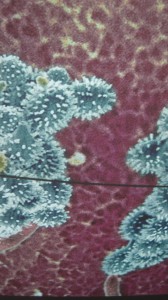 the images in the exhibition “beauty in science” shows a dimension in nature which the human eye is not able to see and capture without the means of technological processes which make these realities visible. particularly the images of bacteria shown reveal an entire universe of peculiar forms, shapes and colours, which are partially recognizable, yet strange and at times even mystical. through the means of scientific research in microbiology and evolution of related technology we are able to further and further explore the multitude and vastness of this particular universe. science and technology make us aware of other dimensions coexisting with our visible reality and can introduce us to its beauties as well as horrors. new worlds and universes that are existing, yet not graspable are unlocked and made visible for the human eye.
the images in the exhibition “beauty in science” shows a dimension in nature which the human eye is not able to see and capture without the means of technological processes which make these realities visible. particularly the images of bacteria shown reveal an entire universe of peculiar forms, shapes and colours, which are partially recognizable, yet strange and at times even mystical. through the means of scientific research in microbiology and evolution of related technology we are able to further and further explore the multitude and vastness of this particular universe. science and technology make us aware of other dimensions coexisting with our visible reality and can introduce us to its beauties as well as horrors. new worlds and universes that are existing, yet not graspable are unlocked and made visible for the human eye.
similarly, artistic expression can unlock and open up new worlds and universes that might seem strangely familiar yet unknown to the viewer. The artist through development of his artistic expression and “researching” his inner world, his intrinsic motivations and interests, can create, or better unlock the door to a new universe, which he shares with the viewer by means of his work. through his peculiar visual language, use of forms, shapes, colors, materials and ways of presentation, the artist reproduces, creates and shapes his visions and ideas, his inner world, and makes it accessible, or at the very least visible, for the public.
scientifically explored worlds are existing, scientifically proven, yet not graspable without the expression of the scientist.
artistically explored worlds are existing within, yet not graspable without the expression of the artist.
science tries to understand the world, art can be an attempt to reflect it and to reflect on it by various means since it can mirror through exaggeration, abstraction, reflection, etc. eventually reproducing what the world surrounding him resuscitates within the artist.
both disciplines, art and science, can open up new universes by extracting information and translating the latter into a framework apt to human understanding through the use of peculiar technologies and techniques.
Science in art museum
Thursday, April 21, 2011
It is interesting to see what happens when something is moved from its ordinary place to a new context. This is exactly what happened at the exhibition Beauty in Science. Purely scientifically pictures were exhibited and hanged with the proposition and question, does this count as art?
The pictures were beautiful and well chosen but still the exhibition felt somehow unfinished and sterile.
But when I entered the last room there was a picture of universe hanging at the roof. It made me think how very surreal it is, that we live inside this image. It made me think about how we so badly want to understand why, and this is what this picture and exhibition communicates to me. About wondering why, about the need of decoding our reality, a desire of understanding and search for the meaning of it all.
That is the reason for religion? Then we asked as scientists. I think art works the same. That’s why the science images works in an art space. Because there is the same questions asked but with different approaches.
zoom in zoom out
Thursday, April 21, 2011
I ‘enjoyed’ the exhibition ‘beauty in science’ in a way, but in a way that I enjoyed biology or physics class in school sometimes.
To see the dazzling complexity of our human existence has since long fascinated me.
To look at life in a scientific way lets me wonder what ‘really matters’.
It demystifies life and mystifies it at the same time.
It lets me see what my ‘living’ is made out of and in what context it is placed.
When I zoom out I feel tiny.
When I zoom in I feel like a world on it’s own.
I am a universe.
I am a small spot in the universe.
Science reminds us, whatever we do we will always be part of nature.
But my fascination didn’t go much further than when I was sitting on my school bench being explained the development of a thought in our brain for example or simply looking at a night sky.
The pictures presented in the museum were without question beautiful and presented in an appealing and nicely detached way… but we have seen them before in books,videos and magazines and sometimes a glance of it even in ‘reality’. For me they have always held a strange beauty, as for the searching eye beauty can lie in almost everything. Their artistic message seems obvious.
Still I felt, the exhibition didn’t go much further than that. The question if science can be art seems utterly irrelevant for me as artists today make use of every aspect of life constantly.
The pictures seemed to be”readymades” in that sense that they were taken from an everyday life context into the “white cube” in order to generate question and thought within the viewer.
Is there a particular sort of appreciation, a sense of harmony, connectedness when ‘nature’s footprint’ is detected in a work of art (or science) ?
I had another realization I want to share: In that exhibition art made a comment on science. science comments on art/beauty as well.
Boijmans
Wednesday, April 20, 2011
Het meest interessante deel van de tentoonstelling ‘Schoonheid in de wetenschap’ was het allereerste filmpje van de tentoonstelling, omdat er veel gebeurt maar weinig bij wordt verteld, zodat je je eigen verbeelding de loop kunt laten; in plaats van iets op microscopisch niveau leek het mij een natuurramp of oorlog gezien vanuit de lucht.
De rest van de tentoonstelling was voor mij geen openbaring in de mogelijk van schoonheid vinden in wetenschap; die kende ik al. Voor een tentoonstelling in een museum vond ik de afbeeldingen ‘leeg’ waardoor ik de stelling
” Scientific imagery is not exactly a “true copy”of reality but a result of a complex process of mediation; both using complex equipment to obtain them, and having to learn how to see them, how to interpret them. “
frappant vond; hoe ver kun je ze interpreteren dan? Het is toch vrij duidelijk? Dit is daar een cel van en die is zo klein dat we hem niet met het blote ook kunnen zien, wat verwondering oproept als we dat uitvergroot wel voor ons krijgen.
De onderdelen ‘de foetus’ en ‘het heelal’ vond ik ten opzichte van al die close ups een fijne tegenstelling; hier word ons eigen kleinheid onderstreept; we denken dat we het hoofdpersonage in ons eigen drama zijn maar we zijn allemaal een stipje op het stipje aarde, en als we de beelden op de foetus-film zien worden we even geconfronteerd met hoe fragiel we beginnen met leven. En de mogelijkheid tot deze associaties vind ik boeiender dan de afbeeldingen die als enige functie hebben dat ze mooi zijn.
Looking at learning / Learning to look
Wednesday, April 20, 2011
We relate to an image in context with the place where we see it. Showing scientific images in an art space can be confusing if you don’t know what you’re in for.
It’s a worthwhile contemporary experiment in the sense that science has become an omnipresent part of our reality, and it’s interesting to explore the limits of the meaning and purpose of scientific images.
I can recognize the blown-up images of molecules because I have seen similar ones before or by reading the description. In a place of science, this might not have happened: I stood back and let them sink in, taking a closer look at the abstract forms, realizing: This could be anything. Not knowing how big this thing is in reality, I can imagine it to be anything. Something small zoomed in or a city from a distance. A couple of times, I saw something I would have liked to copy or use, say, as an animation. There’s a fun thing about those images, beckoning me to play. A thing I found funny was how some images could have passed as modern art, had they been painted on canvas.

worms or curly fries?
A different aspect I thought about was the visual properties of nature. Some of these colors were very nice. I wondered if this was an actual attribute of the object or if a pigment had been added by the scientist to make a certain membrane better visible.
In the end, I do believe that scientific images can be put in an art space to enhance the viewer’s flexibility when it comes to the subject. Personally, I found these images very romantic. The devotion of human kind to find their origin developed with them into being and will never fade. Now that’s love!
Spacecollective.org: Points of View
Wednesday, April 20, 2011
The website spacecollective.org is where geeks feel understood. I don’t meet too many people who know what I mean when I say the word ‚jetpack’. Then again, maybe it’s the wrong word to say. When I explain that I mean a backpack with rockets attached to give you the ability fly, some may think I’m materialistic and lazy, but it’s not only about wanting to have an easier way to school.
It’s about something amazing that in theory we have the technology for, but isn’t quite developed yet, not well enough anyway.
Something virtually real but just out of reach for the general public.
Like the prosthesis you control with your mind, for example, that are being developed over the last years. Dreams are coming true, and it’s all thanks to science.
I rely on science just like another person may rely on god. Some people don’t respect people without a religion. But that non-religion mindset is a religion in itself. I believe in it, I defend it and it is what I am, as in, it is part of everything and everywhere. It is what makes the world a beautiful and cruel place.
The importance of discussing and learning about science is simply that it is interesting as hell. It gave me the shivers when I first learned about the theory of relativity, and the motivation to find out more about what we are, where we are and why is without boundaries.
The beauty of spacecollective.org is the broad spectrum that is posted. It’s not only about technology or progress; it’s just as much about ways of looking and thinking, reflecting on morals and ideas, on value of emotion and logic. It’s philosophical, a root attribute of scientific research.
In my opinion it is crucial to think about those arguments when working with scientific or technological research. We’ve learned over the past decades that it’s not just about getting faster, stronger, better, but that we have to live with the consequences when we change something. Many people will agree with me on this, and just as many people will say the more important thing is to keep it natural.
art equals science
Tuesday, April 19, 2011
About the exhibition Science in Beauty is said that ‘science is a quest for new knowledge about the real world. Art creates its own reality and therefore summons up emotions and often a sense of beauty in the viewer’.
I think that you can switch the words science and art in this sentence and it will also make sense: ‘art is a quest for new knowledge about the real world. Science creates its own reality and therefore summons up emotions and often a sense of beauty in the viewer’.
Art and science, in my opinion, are both used to investigate our reality.
You can read the ‘statements’ about science from Part1 as if it is about art too:
– art as offering the possibility to view in a variety of ways:
zoom in the micro-visuality of things, to literally see the invisible, but also enabling us to view from above, the larger picture (of the globe for example)
– art is not exactly a “true copy”of reality but a result of a complex process of mediation; both using complex equipment to obtain them, and having to learn how to see them, how to interpret them
– for the uneducated eye, if we don’t know what are these images, they have a strange beauty, vivid color, and complex form, they open a possibility for a “second” aesthetic look at nature (the first being simply the appreciation of a landscape), but as an appreciation of an image
– but science as well as art had to invent those images, in the sense that it invented the procedures and the equipment of gaining access to them – which brings the crucial question of the making of the image
So if it’s easy like this to swop the terms art and science around, then what is the difference?
“AVATAR green”
Friday, April 15, 2011
In the avatar-project (design class) I am focusing on, and working with color, color and psychology. At first I found this lamp interesting because of it’s color. I am looking and trying to translate the colours around me and therefore I reacted to the lamp.
From what I have learned about green is that it’s a calming color, pleasing to the senses. For example hospitals uses light green rooms, and that is because green is concluded after studies to have the most calming effect on the patients. But more than that green is a symbol for cycle of life in the nature, and this lamp is the evidence of why, because it is naturally created as an result of the cycle of life.
Green is an ideal color to work with in interior design, because it dominates the nature and we are so used to see it, and therefore it harmonizes with us. In this lamp, green was not an active choice from the designer, it came out of nature itself. This is what I think is beautiful with this lamp. It is like the lamp is created as a platform, for the creation itself. The dark green is a result of living algae, which requires only sunlight, CO2 (carbon dioxide), and water. When taking care of the algae, light is created, in form of tiny amounts of electricity ”breathed” out from the algae.
This is functioning not only as a lamp but in a way a reminder of the ecological system we live in, a reminder of the responsibility we have, because we are a part in it. If I as the owner of the lamp take care of the algae it will reward me with light. So the lamp has two functions according to me, a source of light, a reminder of the cycle of life. Because the light comes is created in an environmental friendly way it also reminds me of the issues of earth, but I don’t think this lamp ”forces” me to think environmental-friendly, neither puts guilt on my shoulders, for me this lamp is instead of a political piece somehow very poetical.
”Mike Thompson created the design of the Latro (Latin for thief) based on a recently proven technology whereby tiny amounts of electricity were tapped from living algae. Latro combines the energy potential of algae and the functionality of a hanging lamp. Synthesizing both nature and technology in one form, Latro is a living, breathing product. Algae require only sunlight, carbon dioxide (CO2) and water, offering a remarkably simple way of producing energy. Owners of Latro are required to treat it like a pet – feeding and caring for the algae that will reward them with light.”

